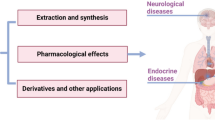Abstract
Two new indirubin-3′-oxime derivatives, indirubin-3′-[O-(3-bromoprop-1-yl)-oxime] (2) and indirubin-3′-[O-(methoxycarbonylmethyl)-oxime] (3) were synthesized. Their structures were confirmed by ESI-MS and NMR spectroscopic method. Both of them (5 μg/mL) significantly caused a elevation of cell growth, alkaline phosphate activity, and mineralization in osteoblastic MC3T3-E1 cells (p<0.05).
Similar content being viewed by others
References
Cuong NM, Tai BH, and Hoan DH (2010) Studies on the acetylation and NMR reassignment of indirubin derivaties. Nat Prod Res 24, 99–105.
Damiens E, Baratte B, Marie D, Eisenbrand G, and Meijer L (2001) Anti-mitotic properties of indirubin-3′-monoxime, a CDK/GSK-3 inhibitor: induction of endo-eplication following prophase arrest. Oncogene 20, 3786–3797.
Eisenbrand G (2006) Chemistry and structure-activity of indirubins. In indirubin, the red shade of indigo, Meijer L, Guyard N, Skaltounis LA, and Eisenbrand G (eds), pp. 135–156. Life and Progress Editions, Roscoff, France.
Hoessel R, Leclerc S, Endicott JA, Nobel MEM, Lawrie A, Tunnah P, Leost M, Damiens E, Marie D, Marko D, Niederberger E, Tang W, Eisenbrand G, and Meijer L (1999) Indirubin, the active constituent of a Chinese antileukemia medicine, inhibits cyclin-dependent kinases. Nat Cell Bio 1, 60–67.
Olivier D, Poincelot MA, Douillard S, Lefevre C, Moureau J, Ferandin J, Bettayeb K, Xiao Z, Magiatis P, Skaltsounis L, Meijer L, and Patrice T (2008) Photoreactivity of indirubin derivatives. Photochem Photobiol Sci 7, 328–336.
Ribas J, Bettayeb K, Ferandin Y, Knockaert M, Garrofe-Ochoa X, Totzke F, Schaechtele C, Mester J, Polychronopoulos P, Magiatis P, Skaltsounis AL, Boix J, and Meijer L (2006) 7-Bromoindirubin-3′-oxime induces caspase-independent cell death. Oncogene 25, 6304–6318.
Sethi G, Ahn KS, Sandur SK, Lin X, Chaturvedi MM, and Aggarwal BB (2006) Indirubin enhances tumor necrosis factor-induced apoptosis through modulation of nuclear factor-?B signaling pathway. J Biol Chem 281, 23425–23435.
Weinreb M, Rodan GA, and Thompson DD (1989) Osteopenia in the immobilized rat hind limb is associated with increased bone resorption and decreased bone formation. Bone 10, 187–194.
Author information
Authors and Affiliations
Corresponding author
Rights and permissions
About this article
Cite this article
Cuong, N.M., Tai, B.H., Hoan, D.H. et al. Synthesis and anti-osteoporosis potential of two new indirubin-3′-oxime derivatives. J. Korean Soc. Appl. Biol. Chem. 53, 22–26 (2010). https://doi.org/10.3839/jksabc.2010.004
Received:
Accepted:
Published:
Issue Date:
DOI: https://doi.org/10.3839/jksabc.2010.004




